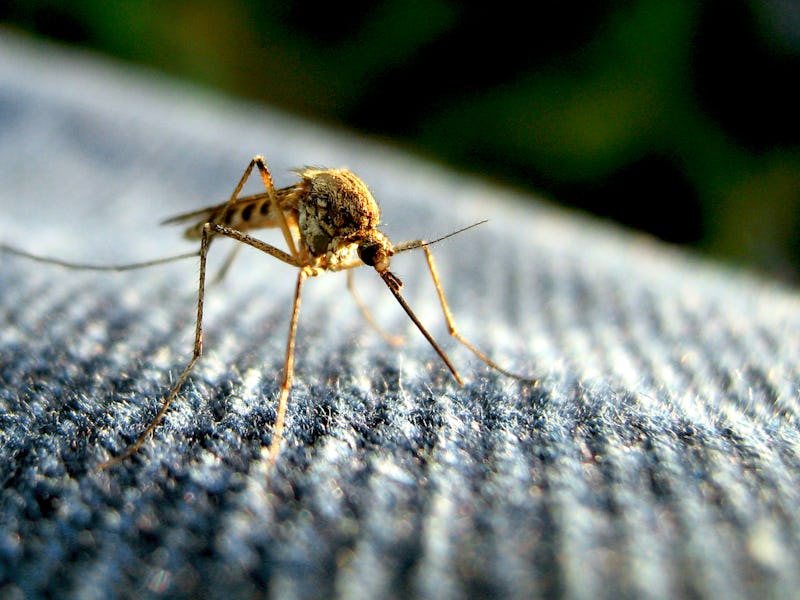Houston's Post-Harvey Mosquito Scare Is Coming in Two Waves
"Livestock have been killed by these things.'

As the residents of Houston and their neighbors seek to recover from the devastation wrought by Harvey, they’re facing a new challenge in the form of two distinct waves of mosquitoes. The first one, which has already begun, takes the form of swarms of “floodwater” mosquitoes. The second, which is due to happen in about three weeks, will consist of a smaller number of disease vector mosquitoes.
Floodwater mosquitoes are those that lay their eggs in preparation for eventual floodwaters. Once the floodwaters arrive and settle, the mosquitoes’ eggs hatch, and the larvae develop. The adults emerge in massive swarms anywhere between three and six days later and are super annoying — but mostly harmless. The Texas Department of Health Services reports that these mosquitos can include species of the Psorophora, Ochlerotatus, and Aedes genera,
“We’re fortunate because these are not the species most commonly associated with human disease,” Charles Allen, Ph.D., an entomologist at Texas A&M AgriLife Extension Service, tells Inverse. That doesn’t mean they’re benign, though.
“Livestock have been killed by these things,” says Allen. “Sometimes they’re exsanguinated [experience severe blood loss] or smothered by the sheer number of mosquitoes swarming around their heads.”
This may sound shocking, but if you see pictures of these mosquitoes, it might not be as surprising. Here’s one, taken by a resident of Needville, Texas, a city about 40 miles southwest of Houston, that Allen shared with Inverse:
Floodwater mosquitoes don't usually carry diseases, but they sure are a nuisance.
Given their propensity to form swarms of as many as a million individuals, it makes sense that floodwater mosquitoes could overwhelm a cow or a horse.
“We have seen animal casualties,” Sonja Swiger, Ph.D., a livestock and veterinary entomologist at Texas A&M AgriLife Extension Service, tells Inverse. “Because numbers are so many, they’ve found them in the nasal passages and lungs of animals that have passed away.”
While these floodwater mosquitoes pose a threat to animals, the real threat to human health will come in about three weeks, when the disease vector mosquitoes have their turn to breed. These mosquitoes, which include Aedes aegypti, Aedes albopictus, and Culex quinquefasciatus, can transmit West Nile virus, Zika virus, and possibly dengue, says Allen. The upside to the annoying floodwater mosquito swarms happening in the immediate wake of the storm, he says, is that they’ll help residents prepare for the disease vector mosquitoes.
“These floodwater mosquitoes probably help us avoid the disease because they force people to take notice and take actions that they need to do to keep from being bitten,” he says.
Aedes aegypti mosquitos, which can carry human disease, are expected to breed about three weeks from now.
There will be fewer disease vector mosquitoes, so vigilance is paramount. Allen and Swiger both recommend that any southeast Texas residents spending time outside should wear long sleeves and plenty of mosquito repellant (something containing DEET works best).
Currently, the Texas Department of Health Services is helping control the first wave by spraying the pesticide naled from airplanes to cover as much area as possible. When it comes to the second wave, though, residents will have to do their part. Allen says that the disease vector mosquitoes — so-called “container-breeders” — usually don’t travel more than 200 yards in their lifetime and typically hatch in small bodies of standing water that could accumulate among the debris left by Harvey.
“If you have them, you or your close neighbors have reared them,” he says. “They didn’t come from the pasture or the park, they came from your backyard or your neighbor’s back yard.”
He recommends observing the 4 Ds: 4 dress in long sleeve shirts and pants, dump standing water, defend with repellants, and dawn and dusk are the times of day you’re most likely to be bitten. And of course, he reminds Texas residents — and possibly Florida residents, too — that just because the swarms subside doesn’t mean you’re in the clear.
“I worry more that when flood waters go down, people may not wear repellant and long sleeves.”